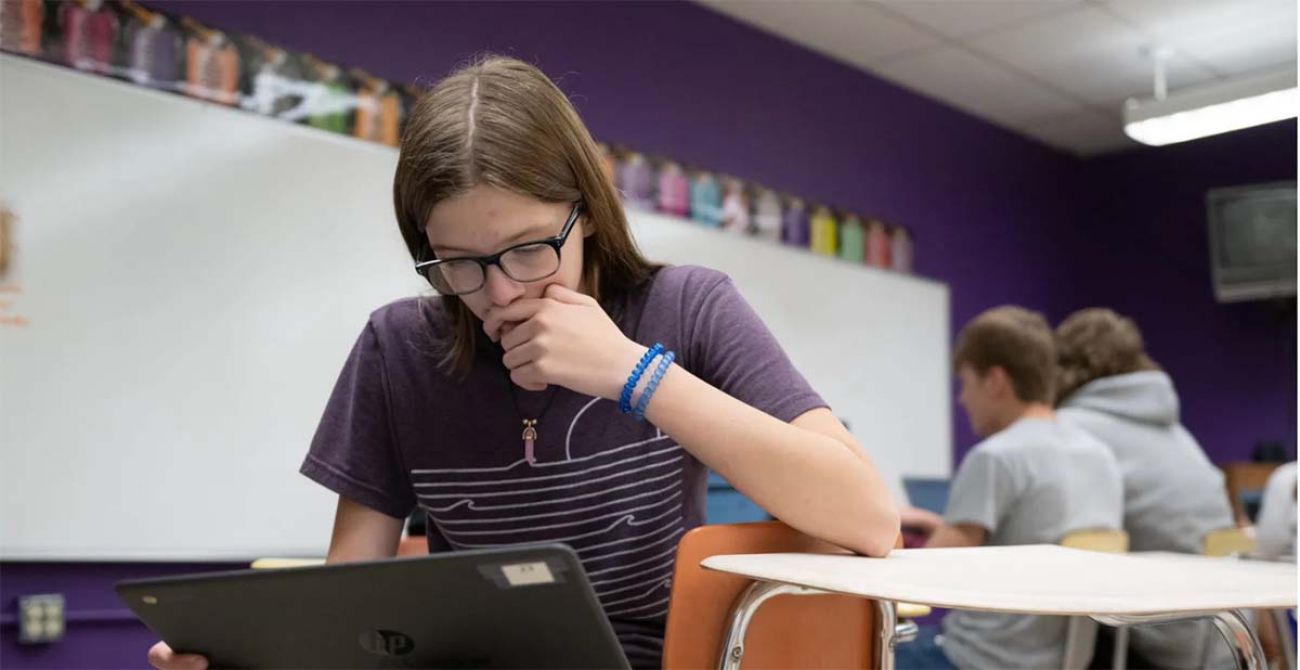Michigan’s rural school districts plead for more bus and broadband funding

- Michigan’s geographically large, rural school districts face unique challenges that the state isn’t meeting
- Transportation costs are daunting, it’s difficult to attract teachers and mental health and broadband services are scarce
- MSU researchers urge state leaders to create a rural policy agenda that would help rural students compete with non-rural peers
Tom McKee was an 11th grader in rural Michigan when a “grow your own” teacher training program sold him on a career in education.
Even so, McKee might have not imagined that he would one day go on to work as a superintendent, athletic director, and bus driver in rural Michigan — much less that he would hold those jobs simultaneously, as he did in his former job at Whitefish Township Community Schools.
McKee, now superintendent of Rudyard Area Schools in the Upper Peninsula, says he loves rural education for the tight-knit schools and the chance to make an impact on kids in his own community. But he says districts like his face challenges that haven’t been taken seriously enough by the state.
“Wearing those multiple hats is not appropriate,” he said. “But we do that in our rural communities because we have to to survive.”
Dozens of rural superintendents echoed that sentiment in recent years in interviews with researchers at Michigan State University. Rural schools face a unique set of challenges linked to their geography, district leaders told the authors of a new report titled “Educational Opportunities and Community Development in Rural Michigan: A Roadmap for State Policy.”
The research team studied districts that the National Center for Education Statistics defines as “rural” or “town.” These districts cover most of Michigan’s land area, but they are sparsely populated: There are 8 students per square mile in the average rural district, compared with 137 per square mile in nonrural districts.
Large, sparsely populated districts make for long, expensive bus routes. Attracting teachers to isolated locales can be difficult. Access to medical services, mental health providers, and high-speed internet can be hard to come by.
Meeting those challenges come with a price tag. But Michigan spends only a small amount to specifically support isolated rural schools through a $9 million program that the report calls “a very low, poorly calibrated, and inadequate recognition of the cost disadvantages experienced by rural schools.”
“There’s nothing approximating a rural policy agenda in this state, and that’s going to have to change,” said lead researcher David Arsen, professor of education policy and K-12 administration. “The whole policy debate has been heavily urban focused,” he added.
State officials tout the latest education budget, which included funding increases for all schools and specific boosts for student mental health and for isolated districts. A federal infrastructure bill passed in 2021 will send at least $100 million to Michigan to connect 398,000 residents to the internet, about a quarter of those estimated to be without a connection.
The new state budget includes funding to help school districts consolidate, which some say would help reduce costs for small, rural districts in particular. Some communities view school consolidations as a threat to local identity.
Despite the new investments, many superintendents said they need more funds in particular for transportation, especially given the current price of fuel, which is down from its peak in June, but well above last year’s prices.
Rural districts spend on average $200 more per pupil on transportation than nonrural districts, and the 25 rural districts with the highest transportation spending averaged $2,170 per pupil, or nearly a quarter of their base funding.
Rural districts in Michigan are generally represented by Republican lawmakers, many of whom have fought for additional funding for their schools. Still, the Michigan GOP, which has controlled the legislature for a decade, has largely focused its education agenda on school choice policies that mostly affect urban areas.
“I think school choice is good,” Arsen said. “It’s not particularly effective in areas where you have a low density of schools like rural Michigan.”
Steve Yoder, the GOP chairman for Michigan’s first congressional district, which covers the Upper Peninsula and the northern Lower Peninsula, said his party ought to put more emphasis on supporting rural education.
“Typically a lot of Republicans like to be on the conservative side and be fiscally responsible, but in a lot of these underserved communities Republicans need to get the message out that we are here to put money into those communities to recruit teachers and get those grades up,” he said. “That’s something that we need to work on.”
Growing up in several school districts in rural Maine, Jessica Drescher, a doctoral candidate at Stanford University who studies rural educational opportunity, saw firsthand the constraints facing isolated districts.
In a national study of rural districts, Drescher found that rural students overall performed slightly below their nonrural counterparts on standardized tests. But she found that the differences were much more stark when she made comparisons within racial groups: Rural white students fared significantly worse than nonrural white students, and so on within most racial categories.
Rural students experience poverty at similar rates to urban students in Michigan, putting them at a significant disadvantage compared with their suburban peers. Poverty is correlated with various negative academic outcomes.
Policymakers have to look more narrowly at the needs of rural areas if they want to make a difference for students there, the report argues.
Allen Pratt, executive director of the National Rural Education Association, agrees.
“You don’t want a cookie cutter that’s designed for Brooklyn when you work in the Upper Peninsula of Michigan,” he said.
Arsen and his team of four researchers spent four years interviewing 25 rural superintendents. Their districts cover 88 percent of Michigan’s total land area but enroll fewer than a third of the state’s students. Their schools are smaller, their staffs are harder to recruit, and their students are more spread out. While some rural districts share resources through county-wide partnerships, many superintendents told researchers that they struggle to offer specialized programs, such as AP courses, because of the high cost of running a classroom with only a handful of students.
Despite their low enrollments, rural schools are inextricably linked to their communities, the report found. They are key drivers of local economies and often serve as central gathering places and sometimes even locations for funeral services, according to the report.
“If the power went out, we had our school open, because we had a generator, and people came and slept,” McKee said of his former district in Whitefish Township, which enrolls 53 students.
His current employer, Rudyard Area Schools, is larger, with roughly 650 students, and is a critical resource for the surrounding community. The district hosts dental clinics and is one of only a few districts in the Upper Peninsula with a school-based health center, which offers routine checkups and mental health care.
McKee often finds himself doing double-duty because attracting and retaining staff is so difficult. The district’s average teacher salary is $41,000, in the bottom third of the state. Paying teachers more is hard, he said, given the district’s transportation spending of roughly $1,000 per pupil, which is in the top 3 percent statewide. And it’s tough to persuade prospective employees to move to a remote area. McKee says more than two-thirds of his employees graduated from Rudyard or a district nearby.
Arsen said lawmakers can help by prioritizing equity, efficiency, and local control when making policy decisions.
Among the report’s recommendations to the Legislature are to:
- Pay for a study of the costs of isolated education, then cover those costs.
- Encourage cooperation among rural communities to pool resources needed to bring broadband to the region and make it more affordable and accessible to rural residents.
- Enact place-based education policies that specifically address the needs of rural communities.
- Ensure education policies are integrated with broader community development strategies.
“These rural schools are the heart of communities,” he said. “They are places where people really care for the kids. We were impressed by that, but we were also impressed that it’s tough, and they need additional help to serve the kids well. … With changes in policy that are within reach, we could make a lot of progress.”
Koby Levin is a reporter for Chalkbeat Detroit covering K-12 schools and early childhood education. Contact Koby at klevin@chalkbeat.org.
Tracie Mauriello covers state education policy for Chalkbeat Detroit and Bridge Michigan. Reach her at tmauriello@chalkbeat.org.
Michigan Education Watch
Michigan Education Watch is made possible by generous financial support from:
Subscribe to Michigan Education Watch
See what new members are saying about why they donated to Bridge Michigan:
- “In order for this information to be accurate and unbiased it must be underwritten by its readers, not by special interests.” - Larry S.
- “Not many other media sources report on the topics Bridge does.” - Susan B.
- “Your journalism is outstanding and rare these days.” - Mark S.
If you want to ensure the future of nonpartisan, nonprofit Michigan journalism, please become a member today. You, too, will be asked why you donated and maybe we'll feature your quote next time!






